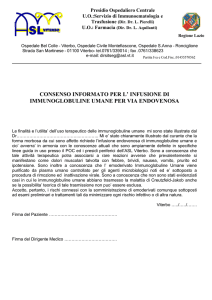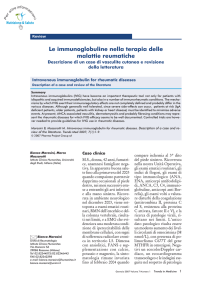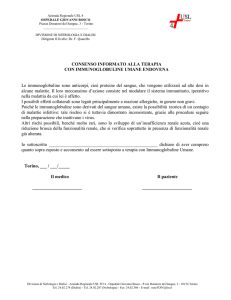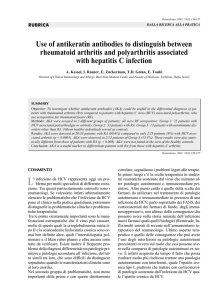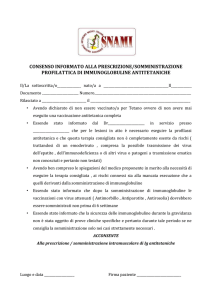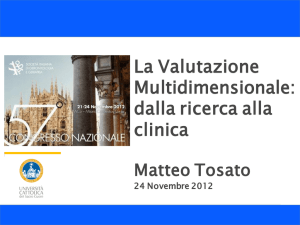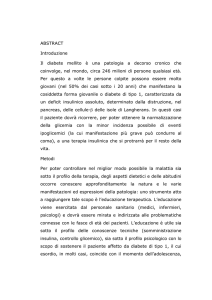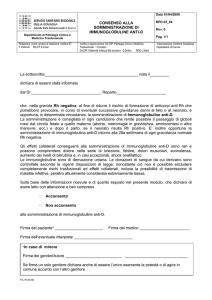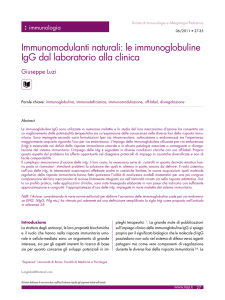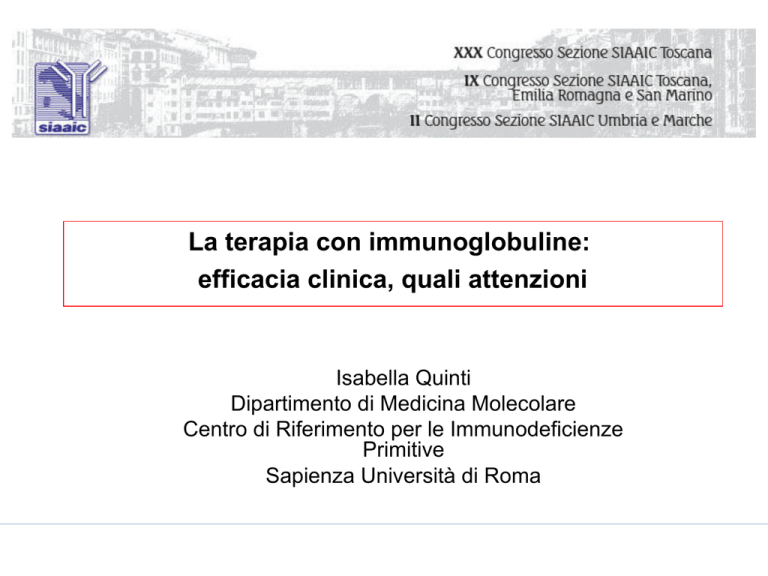
La terapia con immunoglobuline:
efficacia clinica, quali attenzioni
Isabella Quinti
Dipartimento di Medicina Molecolare
Centro di Riferimento per le Immunodeficienze
Primitive
Sapienza Università di Roma
Landmarks in the History of Immunoglobulin Replacement Therapy
Janeway and Gitlin prefer IM
injections, and this becomes
standard of care in US2
1952
IVIG introduced and becomes
standard therapy due to
reduction of bacterial and
non-bacterial infections4
1953 1955
Bruton treats first patient diagnosed
with agammaglobulinemia with SC injections
of immune serum globulin (ISG)1
1.
2.
3.
4.
5.
1980
Renewed interest
in SCIG as alternative to
IV therapy, especially for
home use5
1990s
Berger introduces batterypowered pumps to slowly
administer IM ISG by SC route3
Bruton OC. Pediatrics. 1952;9:722-728.
Berger M. Clin Immunol. 2004;112:1-7.
Berger M. et al. Ann Intern Med. 1980;98:55-56.
Quartier P. et al. Jour Pediatrics. 1999;134:5:589-596.
Abrahamsen TG. Et al. Pediatrics. 1996;98:1127-1131.
2006
First SCIG
Licensed in US
Il Consumo di immunoglobuline in Italia e nel mondo
Indicazioni cliniche
Condizione clinica
Indicazione
Immunodeficienze primitive
Nei difetti di produzione anticorpale e nelle
altre forma di immunodeficienza primitiva
combinata
Trombocitopenia idiopatica
Nelle condizioni in cui è necessario ottenere
un rapido aumento del numero di piastrine
per il controllo di una emorragia.
Sindrome di Kawasaki
Nella prevenzione di aneurismi delle
coronarie
Leucemia linfoide cronica e mieloma
Nella prevenzione di infezioni batteriche nei
pazienti con ipogammaglobulinemia ed
infezioni recidivanti batteriche
Infezione da HIV
In pediatria
Trapianto di midollo
In pazienti > 20 anni per ridurre il rischio di
sepsi, polmonite interstiziale, GVH acuta nei
primi 100 giorni dal trapianto
Sindrome di Guillain Barré
Efficacia clinica sovrapponibile alla
plasmaferesi
Neuropatia Motoria Multifocale
CIDP (Registro AIFA)
Autorizzazione limitata solo ad alcuni
prodotti commerciali
FDA approved indications for the therapeutical usage of polyvalent human
immunoglobulins.
Primary Immune Deficiencies
Chronic lymphocytic leukaemia
Paediatric HIV infection
Kawasaki disease
Allogeneic bone marrow transplantation
Chronic inflammatory demyelinating polyneuropathy
Kidney transplantation involving a recipient with a high titre or an ABOincompatible donor
Multifocal motor neuropathy
Clinical conditions that might benefit from immunoglobulin treatment according to Food and Drugs
Administration
additional approved indications with criteria*
FDA additional approved indications with criteria
Neuromuscular disorders
Guillain-Barré syndrome
Relapsing-remitting multiple sclerosis
Myasthenia gravis
Refractory polymiositis
Polyradiculoneuropathy
Lambert Eaton myasthenic syndrome
Opsoclonus-myoclonus
Birdshot retinopathy
Refractory dermatomyositis
Haematologic disorders
Autoimmune haemolytic anaemia
Severe anaemia associated with parvovirus B19
Autoimmune neutropenia
Neonatal alloimmune thrombocytopenia
HIV-associated thrombocytopenia
Graft-versus-Host disease
CMV infection or interstitial pneumonia in patients undergoing BMT
Dermatologic disorders
Pemphigus vulgaris
Pemphigus foliaceous
Bullous pemphigoid
Mucous-membrane pemphigoid
Epidermolysis bullosa acquisita
Stevens-Johnson syndrome
*Requiring documentation of contraindications or lack of response to conventional therapies
Le indicazioni cliniche all’uso delle immunoglobuline:
vecchi criteri e nuove evidenze
-Individualizzare il trattamento
-Livelli di evidenza
-Monitoraggio degli eventi avversi
-Monitoraggio dei rischi associati ai nuovi metodi di preparazione delle
immunoglobuline
Individualizzare il trattamento
Adequate Patient’s Outcome Achieved
with Short Immunoglobulin Replacement Intervals in Severe
Antibody Deficiencies
Cinzia Milito & Federica Pulvirenti & Anna Maria Pesce &
Maria Anna Digiulio & Franco Pandolfi &
Marcella Visentini & Isabella Quinti
J Clin Immunol (2014) 34:813–819
DOI 10.1007/s10875-014-0081-9
Objective:
To determine for each patient the best interval between immune
globulins administration in order to:
• Keep IgG trough levels >500 mg/dL,
• Minimize of major infections (pneumonias and infections
requiring hospitalization),
• Minimize of adverse events (AE).
STUDY DESIGN
3
m
o
n
t
h
s
ENROLLMENT
(108 patients)
DROP OUT
(8)
REFUSE TO
COMPLICATIONS
(52)
dosage adjusted to 2
weeks interval
(48)
maintain standard
treatment with 3 or 4 weeks
interval
(52)
Patients assessment relative to the
study objective
Patients assessment relative to the
study objective
REDUCE
IVIG
INTERVAL
9
m
o
n
t
h
s
GROUP 2
FEWER DISEASE-ASSOCIATED
GROUP 1
High risk
(56)
Not achieved
(6)
SHIFT
TO
1-WEEK
INTERVAL
CUMULATIVE IVIG
DOSE ADJUSTED
UNTIL THE STUDY
OBJECTIVE
Achieved
(42)
Not achieved
(4)
Achieved
(48)
MAINTAIN
SHIFT TO
2-WEEKS INTERVAL
MAINTAIN
3-/4- WEEKS
2-WEEKS
INTERVAL AND
DOSAGE
INTERVAL
Individualizzare il trattamento
Health care delivery systems are quickly changing in response to
economic pressures and concerns about quality of care. The
system of care is itself an important determinant of patient
outcomes.
Elucidating
the effects of the system of care on patient outcomes
98% of patients achieved the objective of the study.
requires new methodologic approaches in order to identify what
- Patientsin
who
had low switched
memory
cells and low
IgA serum
levels and/or are affected by
works
which
setting
andBunder
what
conditions.
bronchiectasis and/or enteropathy and/or continued to experience adverse events despite premedications,
achieved the study objective by shortening the administration intervals to 2-weeks or to 1-week without the
need to increase the monthly cumulative immunoglobulin dosage and its relative cost.
Personalized health research presents further methodologic
- The adverse events
wereemphasis
reduced by administrating
low Ig
a single setting.response
challenges,
since
is placed
ondosages
the inindividual
rather
than on the population
- Patients without risk factors achieved the study objective with immune globulin replacement administered
with the widely used interval of 3 or 4 weeks.
N Engl J Med 367;9, august 30, 2012
Livelli di evidenza
Monitoraggio degli eventi avversi
-mialgia
-febbre
-brividi
-cefalea
-nausea
-vomito
-difficoltà respiratoria
-manifestazioni a carico del sistema vascolare quali
variazione della pressione sanguigna, tachicardia
-reazioni gravi di tipo anafilattico
-insufficienza renale acuta (dopo alte dosi di IVIG)
-neutropenia
-anemia emolitica acuta
-aumento della viscosità del sangue (solo dopo alte dosi)
-aumento del rischio di aggregazione piastrinica tale da
giustificare episodi trombotici e vaso-occlusivi (solo dopo
alte dosi)
-meningite asettica/encefalite
Le immunoglobuline
sono un farmaco
biologico e come per
tutti i farmaci biologici
la tollerabilità
individuale ai diversi
prodotti commerciali è
ampiamente
dimostrata.
E’ quindi necessario
avere a disposizione
più prodotti in modo da
poter mantenere la
continuità terapeutica.
Monitoraggio dei rischi associati ai nuovi metodi di preparazione delle immunoglobuline
Production Processes
Cohn like
Modern
≥ 2.5 g / L
≥ 3.5 g / L
References: J. Am. Chem. Soc., 68:459-475 (1946); J. Am. Chem. Soc., 71:541-550 (1946)
Immunoglobuline e trombosi
24 Settembre 2010
EMA/CHMP/591722/2010
Comunicato stampa
L’ Agenzia Europea dei Medicinali raccomanda la sospensione di
Octagam in tutti gli Stati Membri della UE
Raccomandazioni del CHMP basate sul rischio di reazioni tromboemboliche.
L’Agenzia Europea dei Medicinali ha raccomandato la sospensione
dell’autorizzazione all’immissione in commercio per Octagam (immunoglobulina
normale umana), di Octapharma GmbH e il richiamo di tutti i lotti attualmente
disponibili sul mercato in Europa.
Immunoglobuline ed emolisi
Anti-A in Cohn like versus Modern Processes
• Cohn like processes have ≥ 2 titer step reduction capacity
20
Acute haemolysis
The eluted antibodies had the same specificity found in the lots of Ig infused at the
time of the haemolytic episode.
Comment: Patients with acute haemolysis due to passive transfer of to irregular antibodies had a more
severe haemoglobin drop and higher reticulocyte percentages than patients who received Ig products
containing anti-A blood group antibodies (5,7 ± 1 g/L vs 1,3 ± 0.2 g/L; 9.8 ± 2.5 % vs 3.2 ± 1.1%,
respectively).
Blood group antibodies and irregular antibodies in IVIG and SCIG
1.Reactive RBCs IgG antibodies
without conventional specificity
were present in 15/16 lots.
2.The titers of blood group
anti-A and anti-B antibodies in
the Ig preparations were within
those recommended by the
European Pharmacopoeia
(<1:64 dilution at 5% (w/v))
3.2/2 lots from one brand were
positive for anti-C and anti-D.
4.2/3 lots from one brand were
positive for anti-c.
The European Pharmacopoeia does not recommend the test for the presence of anti-C anti-c and antiD antibodies.
Haemolysis following IVIG administration?
•
•
•
•
•
Haemoglobin levels showed a mild decrease in
71% of patients
– pre-infusion 13.8 ± 1.4 gr/dL,
– 1 day post 13.0 ± 1.3 gr/dL
– 7 days post 13.8 ± 1.2 gr/dL
Hb levels returned to the same pre-infusion
level after 21 days.
A mild increase in serum total bilirubin levels
was observed following Ig administration:
– pre-infusion 0.31 ± 0.24 mg/dL
– 1 day post 0.75 ± 0.94 mg/dL
– 7 days post 0.69 ± 0.92 mg/Dl
Haptoglobin and LDH levels remained
unchanged.
Reticulocyte counts were increased in 6/16
patients before Ig and in 8/16 after 7 days.
2 /16 patients before infusion and 24 hours postinfusion. Had a DAT positive test. Eluates from
patient’s RBCs showed An anti-A alloantibody
baseline
+ 24 h
+ 7 days
+ 21 days
baseline
+ 24 h
+ 7 days
Conclusioni
• Post-Immunoglobulin haemolysis can occurred in PAD patients receiving
replacement dosages.
Ig at
• Haemolysis was due to anti-A in 6 patients, to anti-C and anti-D in 1 patient and to
anti-C antibodies in 2 patients, passively transferred through Ig
• Polyvalent Ig preparations can contain multiple clinically significant antibodies that
could have unexpected haemolytic consequences, as anti-C and anti-c
• Mild haemolytic reactions can be easily missed and the true incidence of such
reactions is difficult to document without careful clinical and laboratory follow-up.
• For PAD patients under Ig, the occurrence of mild adverse events are outweighed by
the benefits of IVIG and SCIG therapy; however, the clinical consequences of the
passive transfer of blood group antibodies should be identified.
• In terms of safety the issue of acute and chronic haemolysis in long term recipients of
immunoglobulin treatment administered at replacement dosages should be more
widely recognized
• The effects of the recent changes in the immunoglobulin production and schedules of
administration should be assessed in studies of drug surveillance
Conclusioni
La somministrazione delle immunoglobuline induce
molteplici effetti sulle funzioni del sistema immunitario
La conoscenza di tali effetti deve essere nota, deve
guidare le scelte normative e le scelte terapeutiche,
deve orientare la ricerca clinica e di base
La terapia deve essere individualizzata
Le immunoglobuline non possono essere considerate
un farmaco generico
E’ necessario formulare una dichiarazione europea
sulla priorità assoluta della indicazione terapeutica
nelle immunodeficienze primitive
Grazie a:
Commissione
Europea
Agenzia
Italiana del Farmaco
Jeffrey Modell
Foundation
UOD Centro di Riferimento
Immunodeficienze Primitive
Azienda Policlinico Umberto I
Sapienza Università di Roma
[email protected]
Tel 06-49972007

